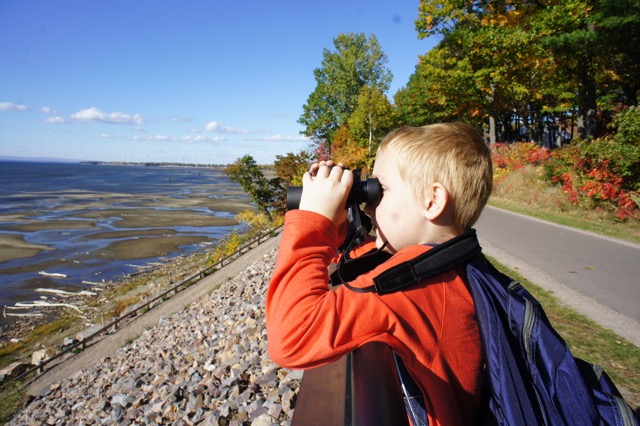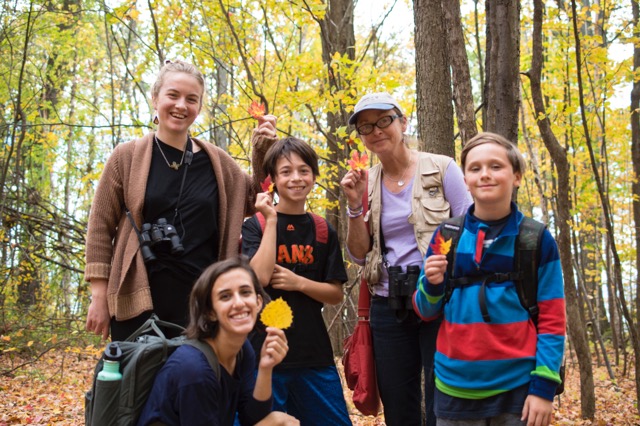Birding to Change the World Takes Flight on Derway Island

Written by David Stanley.
On a warm Wednesday afternoon, a pair of Pileated woodpeckers cackle back and forth amongst the Silver Maples. Their raucous sounds aren’t the loudest calls heard on Derway Island that day. Fifty students from Flynn Elementary led by University of Vermont students in a course called Birding to Change the World descend on the preserve weekly. The group’s laughter, shouting, and sounds of play fill the land. Screams of excitement echo across the river as students celebrate witnessing a beaver slap its tail on the choppy water. A brief moment of quiet and stillness comes only as they lift binoculars to their eyes to gaze upon a Bald eagle perched high above the river. An expression of amazement is uttered as a low, drawn out “wow” from one of the students before they march on hoping to find something else equally exciting. To this unfrequented land that defines Burlington’s northern boundary, these students bring new life and enthusiasm.
In Burlington’s New North End, Derway Island is defined by the last curve of the Winooski River before it meets Lake Champlain. The island, which is actually a peninsula, is an undeveloped 148-acre park managed by the Winooski Valley Park District. Derway is also piece of land abuzz with life. Across the river from the more visited Delta Park, Derway Island Nature Preserve supports a diversity of wildlife, particularly birds. Hooded mergansers, Wood ducks, Osprey, a variety of shorebirds, many species of woodpeckers, and even more species of warblers can be seen along the river or within the floodplain forest that dominates the preserve. Derway becomes alive with a symphony of bird songs as our fair weather neighbors return each spring. This is the landscape the Birding to Change the World goes out every week to explore.
Arguably more enthusiastic and energetic than even the students is the professor behind this community partnership. Dr. Trish O’Kane came to UVM in 2015 after receiving her doctorate at the University of Wisconsin-Madison. During her time there she developed a similar partnership between middle school students who needed mentoring, exposure to the outdoors, and environmental studies and undergraduates at UW-Madison who lacked practical experience. There, students explored a neighborhood wetland park, part of which was slated to be developed, which brought new life into the park and the neighborhood. Thanks to an army of young advocates, Warner Park’s wetland is now protected and has become one of Madison’s hottest birding spots filled with binocular wielding youth. Fortunately Derway Island Nature Preserve can never be developed thanks to dedicated community members such as John Ewing who advocated for its protection with help from The Vermont Nature Conservancy.
During her first semester at UVM, O’Kane met with Flynn Elementary School’s Principal Graham Clarke and together they created a new afterschool program simply known as “Birding Club” for Flynn students. This mutually beneficial relationship extends beyond either educational institute and continues to increase our children’s exposure to the natural world, connect Flynn students with an undeveloped piece of land in their neighborhood, and bring youthful energy to the New North End.
After a lot of preliminary leg work to get the program running, O’Kane is comfortable taking a step back and allowing her students to take the lead. They decide on the focus of afternoons in Derway and bring simple games and objectives along each week. More often than not, the Flynn students lead the way and the UVM students find ways to incorporate their objectives into the events that unfold during the course of the afternoon. Being flexible and allowing Flynn students to take the lead accomplishes another goal of the course: to build confidence and empower our youth.
Each week brings new experiences and opportunities for learning about the natural world. The numerous deer, beaver, and foxes in Derway leave behind plenty of tracks to be followed in the winter months. Fort building and bird watching are popular year round activities while splashing at the river’s edge and climbing trees are reserved for the warmer months. Witnessing the seasonal changes may be the most unique aspect of visiting the same location on a weekly basis. Yellow and red maple leaves coat the ground only to soon be covered by snow during the fall semester. The freezing and thawing of the Winooski River pushes the ducks we gaze upon out of, and then invites them back into the river and the wetlands within Derway. Spring brings seasonal flooding and the students enjoyed splashing around in rain boots as the tree buds swell above.
To the UVM students, the most exciting aspect of the class is bringing the Flynn students to Derway to witness and ponder the wonder of the natural world each week. To the Flynn students, the most exciting aspect is a campus tour on the last day of their semester together. Visiting UVM is like visiting the big city to them. Their excitement over full-sized stadiums, multiple restaurants and dining options, and the hustle and bustle of the Davis Center can not be contained which brings a different kind of youthful energy to campus. Cake and ice cream accompany the commencement of the campus tour as a slideshow displays photos of birds and other wildlife, curious students, and smiles on everyone’s faces. The Flynn and UVM students alike part ways with new skills, knowledge, and confidence while the bond they share and the memories they made will remain grounded in the magical landscape of the Derway Island Nature Preserve.


